Books
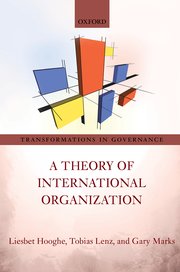 |
A Theory of International Organization: A Postfunctionalist Theory of Governance, Vol. IV Liesbet Hooghe, Tobias Lenz, Gary Marks. Aug 2019. Oxford: Oxford University Press, xxi + 196pp. Published version || Unofficial version Why do international organizations (IOs) look so different, yet so similar? The possibilities are diverse. Some international organizations have just a few member states, while others span the globe. Some are targeted at a specific problem, while others have policy portfolios as broad as national states. Some are captured almost entirely by their member states, while others have independent courts, secretariats, and parliaments. Variation among international organizations appears as wide as that among states. The purpose of this book is to explain this variation, both across IOs and within IOs over time. We show how each IO is an attempt to balance two forces in tension: the functional impetus to tackle problems that spill beyond national borders through joint decision-making, and the communal desire for self-rule, which can dampen international cooperation where transnational community is thin. The implications of postfunctionalist theory for an IO’s membership, policy portfolio, contractual specificity, and authoritative competences are tested using annual data for 76 IOs for 1950-2010. Chapter previews: Table of Contents and Introduction || The basic set-up |
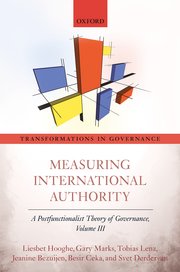 |
Measuring International Authority: A Postfunctionalist Theory of Governance, Vol. III Liesbet Hooghe, Gary Marks, Tobias Lenz, Jeanine Bezuijen, Besir Ceka, and Svet Derderyan. Aug 2017. Oxford: Oxford University Press, xii+ 898pp. Published version || Unofficial version This book sets out a measure of authority for seventy-six major international organizations (IOs) from 1950 to 2010. On the premise that transparency is key in the production of data, we chart a path in laying out the assumptions that underpin the measure. Successive chapters detail the authors’ theoretical, conceptual, and coding decisions. Profiles of regional, cross-regional, and global IOs explain how they are composed and how they make decisions. A distinctive feature of the Measure of International Authority (MIA) is that it breaks down the concept of international authority into discrete dimensions, which are built up from coherent ingredients—the composition and role of individual IO bodies at each stage in policy making, constitutional reform, the budget, financial compliance, membership accession, the suspension of members, and dispute settlement. These observations can be assembled—like Lego blocks—in diverse ways for diverse purposes. Chapter preview: Concept and Measure || Selection of IO profiles: EU profile || ASEAN profile. |
 |
Community, Scale, and Regional Governance: A Postfunctionalist Theory of Governance, Vol. II Liesbet Hooghe and Gary Marks. Aug 2016. Oxford: Oxford University Press, 195pp. Published version || Unofficial version The book argues that jurisdictional design is shaped by functional and communal pressures. Functional pressures arise from the character of the public goods provided by government: their scale economies, externalities, and informational asymmetries. However, to explain demands for self-rule one needs to understand how people think and act in relation to the communities they conceive themselves belonging. The authors demonstrate that scale and community explain basic features of governance, including the growth of multiple tiers over the past six decades; how jurisdictions are designed; why governance within the state has become differentiated; and the extent to which regions exert authority. Chapter previews: Introduction || Designing Jurisdictions || Differentiated Governance || Conclusion |
 |
Measuring Regional Authority: A Postfunctionalist Theory of Governance, Vol.I Liesbet Hooghe, Gary Marks, Arjan H. Schakel, Sara Niedzwiecki, Sandra Chapman Osterkatz, and Sarah Shair-Rosenfield. Jan 2016. Oxford: Oxford University Press, 687pp. Published version || Unofficial version This is the first of four ambitious volumes theorizing the structure of governance above and below the central state. This book sets out a measure of regional authority for 81 countries in North America, Europe, Latin America, Asia, and the Pacific from 1950 to 2010. Subnational authority is exercised by individual regions, and this measure is the first that takes individual regions as the unit of analysis. On the premise that transparency is a fundamental virtue in measurement, the authors chart a new path in laying out their theoretical, conceptual, and scoring decisions before the reader. The book also provides summaries of regional governance in 81 countries for scholars and students alike. |
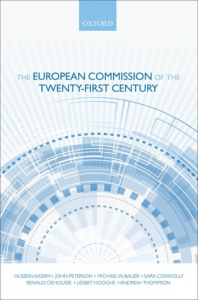 |
The European Commission of the 21st Century Hussein Kassim, John Peterson, Michael Bauer, Sara Connolly, Renaud Dehousse, Liesbet Hooghe, and Andrew Thompson. 2013. Oxford: OUP, 381pp. Published version The European Commission is arguably the world’s most powerful international administration, but also the subject of intense controversy. It is sometimes portrayed as technocratic, monolithic, and unaccountable, and sometimes as fragmented and weakly led. According to some, it is populated by career bureaucrats who want to expand EU competencies and their own power. This book tests these views. Co-authored by an international team of researchers, this book draws on original data from the largest attitudinal survey ever conducted by independent researchers inside the Commission, as well as interviews with senior officials. It provides an authoritative account of the European Commission of the twenty-first century. Chapter previews: Table of Contents & Introduction || What Officials Believe (Hooghe) |
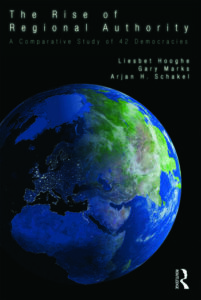 |
The Rise of Regional Authority: A Comparative Study of 42 Democracies (1950-2006) Liesbet Hooghe, Gary Marks, Arjan H. Schakel. 2010. London: Routledge, 224pp. Published version || Unofficial version This book measures and explains the formal authority of intermediate or regional government in 42 advanced democracies, including the 27 EU member states. It tracks regional authority on an annual basis from 1950 to 2006. The measure reveals wide variation both cross-sectionally and over time. The authors examine four influences – functional pressures, democratization, European integration, and identity – to explain regionalization over the past half-century. Table of contents |
 |
The European Commission and The Integration of Europe: Images of Governance Liesbet Hooghe. 2002. Cambridge: Cambridge University Press, XI + 279pp. Published version What kind of European Union do top Commission officials want? Should the European Union Be supranational or intergovernmental? Should it promote market liberalism or regulated capitalism? Should Commission be Europe’s government or its civil service? The book examines top officials’ preferences through analysis of unique data from 137 interviews. Hooghe demonstrates that the Commission has difficulty shaping its employees’ preferences in the fluid multi-institutional context of the European Union. Top officials’ views are better explained by experiences outside rather than inside the Commission: party, country, and prior work leave deeper imprints than length of service, directorate-general, or cabinet. |
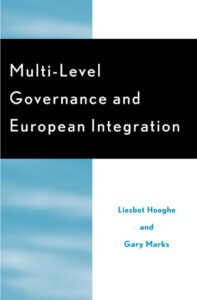 |
Multi-Level Governance and European Integration Liesbet Hooghe and Gary Marks. 2001. Lanham, M.D.: Rowman & Littlefield, XVI + 240pp. Published version European politics has been reshaped in recent decades by a dual process of centralization and decentralization. At the same time that authority in many policy areas has shifted to the supranational level of the European Union, so national governments have given subnational regions within countries more say over the lives of their citizens. At the forefront of scholars who characterize this dual process as multi-level governance, Liesbet Hooghe and Gary Marks argue that its emergence in the second half of the twentieth century is a watershed in the political development of Europe. Hooghe and Marks explain why multi-level governance has taken place and how it shapes conflict in national and European political arenas. Drawing on a rich body of original research, the book is at the same time written in a clear and accessible style for undergraduates and non-experts. |
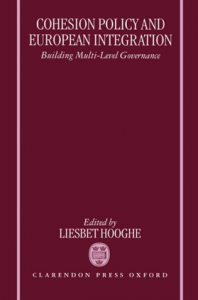 |
Cohesion Policy and European Integration: Building Multilevel Governance Liesbet Hooghe (ed.). 1996. Oxford: Oxford University Press, 458pp. Published version How can one convince potent nation-states to put their sovereignty at risk in common European policies? EU cohesion policy, which absorbs one-third of the EU budget, provides such a puzzle. Since the 1988 reform national governments are required to negotiate with the Commission and regional authorities on how to use cohesion money. How has this European-wide policy eroded national sovereignty in favour of a stronger role for the Commission and more power for Europe’s regions? The first part of the book probes into the policy dynamics at the European level. In the second part, eight country studies evaluate the impact of a single EU policy on territorial relations. The concluding section explains persistent variation in EU cohesion decision making and implementation. |
